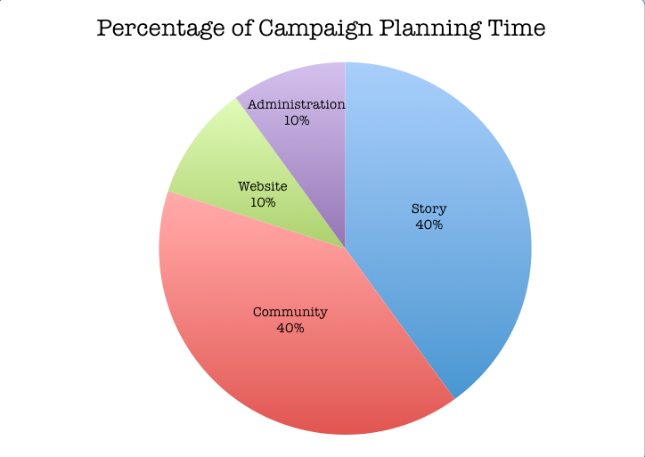When it comes to changing the world, you’d rather be on the front-lines, rather than planning an online fundraising campaign.
You’ve limited time budgeted for executing a fundraising campaign, so how should you make the most of it?
Not All Tasks Are Created Equal
First, let’s look at the elements that we’ve identified in a fundraising campaign:
- Story
- Community
- Website
- Administration
Did you find the second half of the list overwhelming? If so, fear not. If you’re intimidated by the first half of the list, you also needn’t worry.
You probably reacted with trepidation because you anticipate allocating equal amounts of time to work on each phase. More often than not, however, the reality is that the amount of work you put in doesn’t yield the same amount of result.
As you plan your campaign, we suggest allocating most of your time to the story and the community and the remainder to the website and administrative upkeep.
Even the fanciest of fancy-pants websites isn’t what brings in donations, so don’t exhaust your brain power and time on that. Instead, focus your brilliance on the keys to a successful fundraising campaign.

80% of your campaign planning
Establishing the why and the who of the fundraising campaign is the most fundamental step of the process; hence we’d recommend spending 80% of your time on these phases of campaign planning. Consider the story and the community the foundation of the campaign; a sturdy structure can only follow from a solid foundation.
The Story (Why Are We Doing This?) = 40%
If we were to turn your nonprofit into a television series, consider a fundraising campaign an episode. This show is about your organization wanting something and overcoming obstacles to get it, to paraphrase author Donald Miller.
Your fundraising campaign tells a part of that story; you’ll need to determine which part of the narrative it plays. More likely than not, you’re running the campaign to reach a goal:
- You want to send a group of rising high school freshman girls from the South Bronx to sleepaway camp in Vermont to let her get away from the grit of the city for the summer.
- Simple birthing kits and basic medical tools would help an undersupplied, understaffed maternity clinic in sub-Saharan Africa save mothers from dying in childbirth.
Creating, or rather, unearthing the compelling story behind the fundraiser will serve as motivation throughout the campaign, especially the challenging portions of the process.
The Community (Who’s In?) = 40%
Being able to clearly articulate the story, the raison d’etre, of the fundraising campaign leads to the next important step of the process: rallying your community.
A good story makes recruiting fundraisers easy because participating in the campaign won’t be about fundraising. You’re inviting volunteers, fans, and donors to hold a greater stake in the mission of your organization. You’re equipping them to be your storytellers, and the campaign is simply a means of sharing your story.
A clearly articulated, compelling story will help each member of your nonprofit’s community find their place in the greater narrative. They’ll identify the intersection of their individual stories with yours; that’s the sweet spot where your community will grow and new members can join the story.
The community will provide additional motivation; they’ll remind you and one another of the value of your efforts.
20% of your campaign planning
This leaves you with the final two elements of the campaign: the website and the administration. These phases shouldn’t take more than 20% of your planning time.
A platform, like CauseVox, makes it easy to set up a fundraising website that melds seamlessly with your existing website. At this point, you’ll have established the story behind the campaign, which means you already have content with which to populate your website. Your advocates will able to outfit themselves with fundraising websites that they can personalize.
The administrative tasks related to your fundraising campaign, such as ensuring donors their gifts are tax-deductible and monitoring the progress towards meeting the goal, should take minimal time – that is, if the platform you choose is robust yet user-friendly, and automates steps like sending donation receipts.
A gilt frame adds nothing to a blank canvas
A beautiful stage can’t fill the holes of a script and the snazziest megaphone on the market won’t make up for a mediocre message.
So when you set out to launch a fundraising campaign, remember to focus on what truly matters: the story and the storytellers. They put the “fun” in fundraising, which ultimately helps your nonprofit carry on being awesome and doing awesome things.




